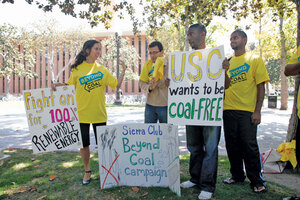Students make push for coal-free energy
Eco-conscious students are calling upon USC to be a model of sustainability and to stop using coal in favor of greener energy sources.
Under the umbrella of the Sierra Club — a national organization — students launched the “Beyond Coal” campaign last week, which aims to reduce USC’s use of coal, thereby setting a precedent for other universities.

Eco-friendly · Students and members of the Sierra Club demonstrated last week in hopes of getting USC to end its reliance on coal for power. - Mike Lee | Daily Trojan
According to the Los Angeles Times, the Sierra Club reported that USC gets 43% of its energy from coal.
Matthew Oden, director of USC’s sustainability program, said USC has little control over its energy sources, as the school’s energy is contracted through the Los Angeles Department of Water and Power.
“A lot of people in our energy department at USC want sustainable energy and solar panels in this university,” Oden said. “The challenge is we’ve been in a contract with DWP where we can’t do that by law. It’s not that we don’t want to, we legally can’t.”
USC’s contract with DWP has been in place for 10 years. That contract, however, expires at the end of this year.
“A lot of people are working on this in our energy department, a lot of work is done to try and make this happen, but it has just never been an option until the end of this year,” Oden said.
William Sealy, a recent USC graduate and an organizer for the California Public Interest Research Group, said the group hopes USC will engage in serious talks with DWP about moving away from coal as they look to renegotiate their energy contract.
“The school can actively talk with the DWP about ways they can change their sources of energy, and move away from coal towards something more sustainable,” Sealy said.
Oden said that many people in the school’s energy department are working to try to move toward more sustainable energy sources and they hope to work with DWP at the end of the year, once the option is available.
“We are in the process of creating a new memorandum of understanding with DWP and that will determine our terms with them,” Oden said. “We are hopeful in working towards this and are looking forward towards a good financial arrangement.”
Mark Bernstein, managing director of USC’s Energy Institute, said he supports the students’ efforts to pressure DWP on using clean energy.
“DWP continues to need to be pushed, no question about it, but they are moving towards using less coal,” he said. “I don’t think USC has done enough, but we don’t have much choice — we have to buy their power. But we are exploring options to use solar panels and lower our energy consumption.”
According to Sealy, USC lags behind other universities that have taken more proactive steps in using clean energy.
“We can definitely increase our renewable energy sources here on campus — like the University of Pennsylvania that receives part of their energy from wind turbines, or Georgetown University which has a whole new building covered head to toe in solar panels,” Sealy said.
The Sierra Club’s “Beyond Coal” campaign is a nationwide movement, involving more than 60 campuses. The Sierra Club argues that universities have the potential to lead the nation into clean energy use.
“I think USC’s purchasing power and influence has the enormous potential to not only change its own campus but to also get the entire city of LA off of coal-generated electricity,” said Trieste Lockwood, the campaign coordinator for USC’s branch of the Sierra Club.
Locally, the “Beyond Coal” campaign also hopes to put pressure on Mayor Antonio Villaraigosa, who vowed in his second inaugural address to go coal-free by 2020.
“It was a really bold and ambitious announcement,” Lockwood said. “We’re here to hold him accountable and make sure he follows through.”
